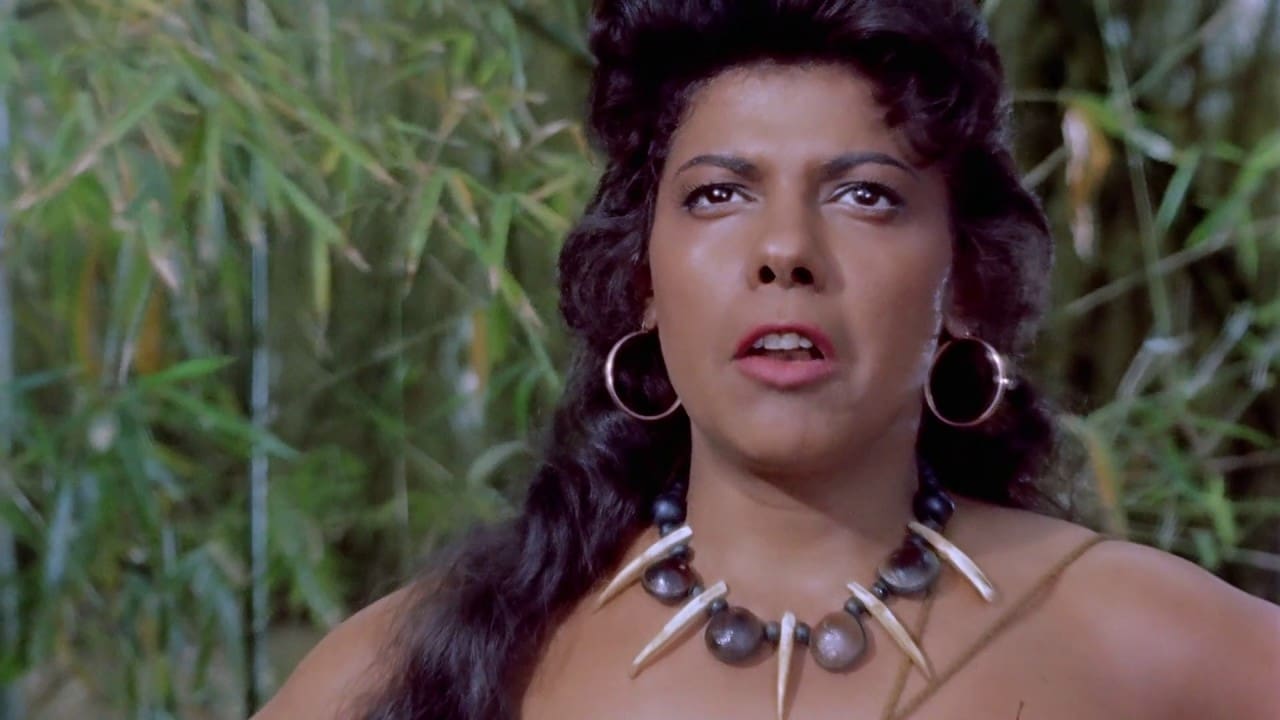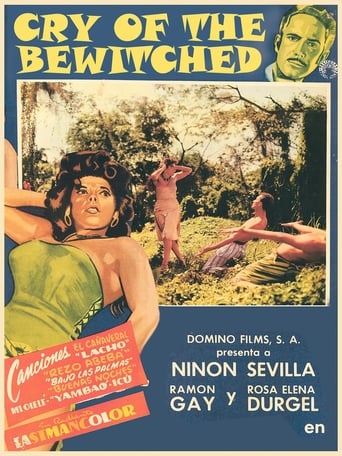

Sorry, this movie sucks
... View MoreIt's no definitive masterpiece but it's damn close.
... View MoreAmazing worth wacthing. So good. Biased but well made with many good points.
... View MoreBlistering performances.
... View MoreI had never expected to hear Ninón Sevilla delivering her lines in English. Although she was dubbed, for the movement of her lips it is obvious that Ninón was saying her lines in English, so I deduced that it was also shot in English for an American version distributed in the United States. I do not know if this version is the only one in color that survived after the vaults of the Mexican national film archive caught fire in 1982 and many negatives and first copies were forever destroyed. Although there is a low resolution copy available in Spanish, it is in black and white, I opted for this foreign version, so the vision of this melodrama, which by itself is already psychotronic, definitely became a weird experience. A while ago I saw Ninón in "Mulata", another film dealing with Santería, but in "Yambaó" there are elements of fantasy: while it is true that there is a respectful treatment of the Yoruba religion (never called "voodoo", as in many American and European films or comments here in IMDb, that make no distinctions among African cults), here we find possessions of spirits and the power of magical brews and invocations. Everything else is natural: prestigious composer Obdulio Morales Ríos wrote the ritual music; musical direction was by Lan Adomian, the Russian-American who wrote the Republican hymn during the Spanish Civil War; and the dances were staged by Rodney, the famous choreographer of the Tropicana cabaret. To reinforce the ethnic-folkloric aspects several Cuban singers are featured: Olga Guillot sings a duet with Ninón, Xiomara Alfaro sings in a funeral scene, and Celina Reynoso plays the landowner's nanny, while there are cameos by popular Paulina Álvarez, the so-called "Queen of Danzonete", and Haitian singer Martha Jean Claude. Also all the dances were shot in exteriors: in fact, almost all the action takes place in open spaces, except for the cave where Yambaó hides with her aunt, the white landlord's hacienda, and the shack where the lovers meet. At first glance it seems that the plot of "Yambaó" takes elements from Cirilo Villaverde's "Cecilia Valdés", known as the national novel of Cuba. But in general what happens in the film is quite common in the island, as well as in most of Latin American countries: in short, it is the typical story of the delirious passion of a mulatto woman for a white man (and vice versa). The cult of the white Spanish man (and the rest of the Caucasian men) is a curious racist introjection. I have never forgotten when a Cuban film student referred to a handsome man he had met, saying "He was so beautiful that he seemed a Spanish man!" This admiration has its complement in a highly favored Cuban cultural trait, which I call "mulattism": the adoration of the mulatto stereotype consists in worshiping mulattoes of both sexes as the epitome of crossbreeding beauty and sensuality. It is very common in the island, where almost all the indigenous people were slaughtered. The drama of the mulatta Yambaó (Ninón) is falling in love with the Caucasian owner and ruler of a cane field in 1850. The woman was raised in freedom by her aunt Caridad, a black slave and santera, who knows about spells, love knots and magic powders. Everybody thinks Caridad died when the previous owner sent her into exile. But Caridad returns with her niece Yambaó and a plan for revenge that will be executed by the young woman: she has to kill the son of the old boss, who is the new owner of the fields (Ramón Gay, who could equally fight the Aztec mummy and doll people, or appear in a drama by Roberto Gavaldón). But Yambaó likes the "whitey" and Caridad's plan screws up. Here Ninón is far from her best works. She was no longer the slender beauty, wears an unbecoming brunette wig and was directed by a rather gray filmmaker, Alfredo B. Crevenna, who had better luck in other projects. But, of course, Ninón is Ninón and as always she dances with passion, and confronts her opposites with her hands on hips and raising her chin. One enjoys her dance and performance, but "Yambaó" is saved above everything else by its music, dances, singers, landscapes of the Cuban countryside and Eastmancolor.
... View MoreThere is such a bias these days against anything which hurts feelings. To these people, I say, shove off! It's time we see things for what they are. In terms of this film, what we have is an imitation, I think, of "South Pacific." Oh, don't roll your eyes, just listen. The use of color and location here reminds me of the best musicals from that era. The depiction of 1800's plantation Cuba is terrific. It's to me definitely more of a musical than a supernatural film, but the latter's influence is not lost. In short, there's enough entertainment to keep a non-horror fan occupied, and enough occult to keep that genre's aficionado awake. It doesn't hurt that in the print I viewed Yambao gets naked. So, let this lowbrow review be a clarion call and a warning. Yambao is just fine.
... View MoreUnfortunately, Ninon Sevilla was induced to reprise her "mulata" in the ill-conceived, poorly directed (Alfredo B. Crevenna) Yambao (1957). Aware that Pedro Armendariz had done his best to steal her limelight in "Mulata" (1954), Ninon was delighted with second-rate co-stars Ramon Gay (from the Aztec Mummy pictures) and Senorita Durgel, with whom she had worked harmoniously in Crevenna's 1956 "Amor y Pecado". So the accent is firmly on Sevilla all the way. Alas, she proves a huge disappointment. The film's poster lists seven songs and dances, but there seemed more a like dreary dozen to me. All but one are total write-offs, while the one that is mildly pleasant has nothing to do with the movie and seems to have been added as an afterthought. Not that the foolish, half-baked story with its copycat echoes of far better films like "Chloe" is any more entertaining. And as for the acting, the word "puerile" comes readily to mind, even to describe the exotic Sevilla herself who way overdoes the eye popping, teeth gnashing and similar amateurish histrionics. What's worse, she disappoints her fans by confining her dancing strictly to repetitive mambo-junko. We keep waiting for director Crevenna to wake up and realize this dime-store potboiler would play better as a comedy. Alas, he never does, even though Ninon's over-the-top scenery-chewing should have caused lightning to strike.
... View More1850, Cuba. The fiery and enticing Yambao (the insanely gorgeous dancer/actress Ninon Sevilla) stirs up trouble on a plantation. She not only gets blamed for a plague that ravages a nearby village (the locals think she's a witch), but also tries to seduce no-nonsense plantation owner Jorge (the solid Ramon Gay). In addition, Yambao does her best to resist falling under the spell of her bitter and vengeful sorceress grandmother. Director Alfredo B. Crevenna treats the lurid story with admirable seriousness and does a nice job of creating a rich and exotic atmosphere. Moreover, the vivid depiction of the small remote sylvan community and its scared, superstitious inhabitants is both credible and intriguing. The occasional nifty music numbers liven things up a lot. Raul Martinez Solares' vibrant color cinematography does the trick. Ditto the lusty and rousing score by Lan Adomian and Obdulio Morales. Sevilla really impresses with her formidable portrayal of the titular character; her dark, sultry beauty, sensuous dancing, and smoldering presence all positively steam up the screen. An entertaining film.
... View More